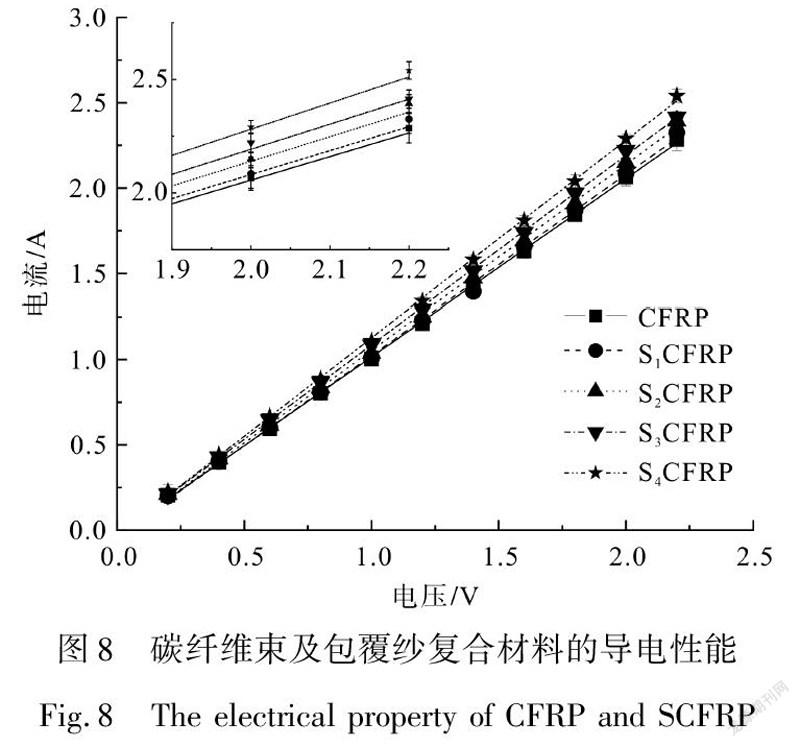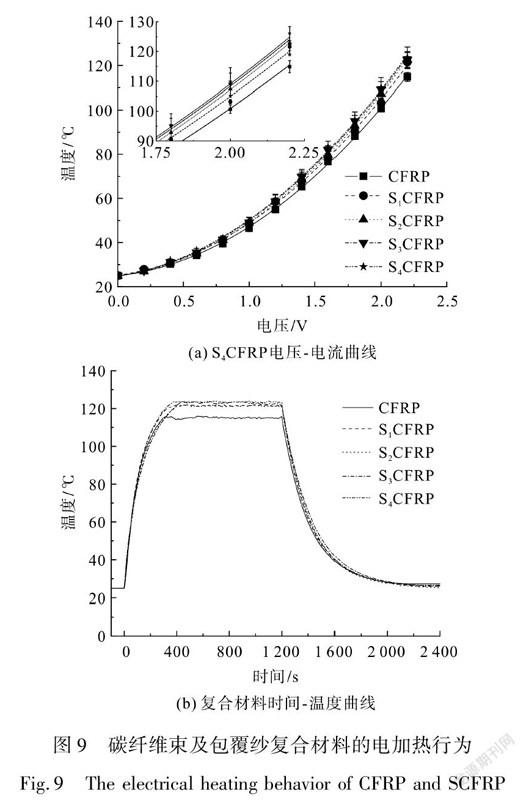蚕丝包覆对碳纤维束及其复合材料电热性能的影响
2022-05-25何锐盛建祥张子航倪庆清傅雅琴
何锐 盛建祥 张子航 倪庆清 傅雅琴



摘要: 为了进一步提高碳纤维及其复合材料的电热性能,文章采用空心锭子纺丝法制备一系列蚕丝包覆碳纤维复合丝,并采用真空模塑方法制备蚕丝包覆碳纤维复合丝/环氧树脂复合材料。通过场发射扫描电子显微镜(SEM)观察蚕丝包覆碳纤维复合丝的形貌,通过直流稳压电源和红外热成像仪探讨碳纤维束和包覆纱及其复合材料的电热性能。结果表明:蚕丝包覆碳纤维复合丝的电阻随蚕丝包缠度的增加而降低,当包缠度达到最大(包覆度100%)时,包覆纱的电阻降低了5.54%,其复合材料电阻降低了10.4%;当外加电压为2.2 V时,包缠度最大的包覆纱温度为522 ℃,相比于未包覆的碳纤维束的43.8 ℃增加了19.2%,同样的电压下,包缠度最大的包覆纱复合材料温度为123.47 ℃,比碳纤维复合材料温度(114.85 ℃)增加了7.5%。显示了蚕丝包覆对碳纤维及其复合材料的电热性能有显著的提升作用。
关键词: 碳纤维;蚕丝;包覆纱;复合材料;电热性能
中图分类号: TS102.33;TB332文献标志码: A文章编号: 10017003(2022)05000107
引用页码: 051101DOI: 10.3969/j.issn.1001-7003.2022.05.001
碳纤维(CF)除了具有优异的机械性能外,还具有良好的电热性能,无论是以复合材料的形式还是作为智能纺织品的形式,碳纤维正在从航空航天等国防军事领域扩大到汽车制造、电子电气等民用领域[1-3]。碳纤维属于乱层石墨结构[4],在石墨同一片层的碳环中,所有碳原子形成一个巨大的π键,而这个大π键中的所有电子均能够在层内自由流动,在电场作用下就会发生定向移动而产生电流[5],因此碳纤维材料良好的导电性能,其电阻率一般为(1.0~1.5)×10-3/cm[6]。与传统金属加热器件相比,碳纤维具有密度小、加热效果好等特点,然而由于层状石墨结构的缺陷及在使用过程中不可避免地会出现磨损断裂情况,存在碳纤维的电热性能发挥不充分,在使用过程中易磨损断裂的问题,影响其在电加热领域应用的范围[7]。因此,常常采用化学试剂对碳纤维进行表面处理,提高其电热性能。
通过高温处理来提高石墨化程度、在碳纤维表面掺杂导电粒子等方法来提高碳纤维的导电导热已有大量的研究[8-12]。Cao等[13]将硫酸镍和氯化镍作为镍源,采用电镀法在碳纤维表面镀上0.49 μm的镍层来提高碳纤维的电热性能,当施加1.75 V电压时,未镀镍的12 K碳纤维束为140.1 ℃,而镀镍碳纤维束最高可以达到166 ℃的温度,其复合材料的电热转化率也比未表面处理的高出32.5%,使碳纤维复合材料在电加热除冰方面具有更好的应用前景。Qin等[14]将碳纤维浸入到稳定的石墨烯纳米片悬浮液中,制备了石墨烯纳米片涂层的碳纤维/环氧树脂复合材料,使复合材料的电导率增加了165%。Du等[15]将碳纤维在乙醇火焰中低温(450 ℃)原位生长碳纳米管,使得碳纤维横向和沿纤方向上的电导率分别提高了170%和70%,而拉伸性能无明显下降,但这些对碳纤维的表面处理,均需要通过化学方法实现,一方面需要消耗较多的能量,另一方面存在增加环境负荷的风险。
蚕丝作为柔性有机天然纤维,由内层的丝素蛋白和外层的丝胶蛋白组成,在拉伸强度、断裂伸长率及能量吸收方面均表现出优异的性能[16-18],由氨基酸组成的丝胶与环氧树脂中的氨基结合形成牢固的化学键,与环氧树脂基体的黏合性能高于其他植物纤维。为此,本文采用空心锭子纺丝方法将蚕丝包缠在碳纤维束外,使松散的碳纤维束变得紧实,制备一系列不同包缠度的蚕丝/碳纤维包覆纱,之后制备蚕丝/碳纤维包覆纱增强环氧树脂复合材料(简称SCFRP),研究了不同包缠度的蚕丝/碳纤维包覆纱及其复合材料的电热性能,以期在不提高碳纤维含量的情况下,提高碳纤维及其复合材料电热性能,为进一步提高碳纤维及其复合材料的电热性能提供新途径。
1实验
1.1材料与试剂
直径7 μm的3 K聚丙烯腈基碳纤维(T300B,日本东丽公司),22.2/24.4 dtex生丝(湖州大东吴丝绸有限公司),双酚A型环氧树脂(AM-8927A)、胺类固化剂(AM-8927B)(上海惠柏新材料科技股份有限公司),导电银胶(深圳奥斯邦股份有限公司),小型中空锭子纺丝系统(实验室自制)。
1.2方法
1.2.1蚕丝/碳纤维包覆纱的制备
蚕丝包覆碳纤维的制备如图1所示,碳纤维束经过引导后以恒定速率向上穿过空心圆筒,空心圆筒上的蚕丝与空心轴以相同的速度顺时针旋转(Z向)。经过一次包缠后,以同样的方法,将空心圆筒的旋转方向改为逆时針方向旋转(S向),将蚕丝第二次包覆在已经用蚕丝包覆后的碳纤维束外,得到两次包缠方向不同的包覆纱。通过控制Z向和S向蚕丝根数及空心圆筒旋转速率得到一系列不同包缠度和包缠圈数的蚕丝/碳纤维包覆纱,命名为S1CF~S4CF,如图2所示。包覆参数如表1所示。
1.2.2蚕丝/碳纤维包覆纱环氧树脂复合材料的制备
首先将20束碳纤维和蚕丝/碳纤维包覆纱分别平铺在不锈钢模具里并施加一定的张力使其处于伸直状态,放入60 ℃烘箱干燥12 h。之后将环氧树脂AM-8927A、胺类固化剂AM-8927B按照10︰3质量比混合均匀,在450 r/min速率下搅拌10 min,放置于真空烘箱中除去气泡,缓慢地浇注在事先准备好的模具中。最后将其置于真空烘箱中100 ℃固化3 h,再在150 ℃下固化15 min,冷却脱模后得到包覆纱环氧树脂复合材料,命名为CFRP和S1CFRP~S4CFRP,如图3所示。复合材料中碳纤维和蚕丝体积分数如表2所示。
1.3仪器与设备
采用Ultra-55场发射扫描电镜(FE-SEM,德国蔡司公司)表征碳纤维束及包覆纱的表面形貌;采用美国Instron 3367万能材料试验机测量包覆前后碳纤维束的拉伸强度;利用直流稳压电源(MS-6050)探讨碳纤维束、不同包缠度包覆纱及其复合材料电热性能;红外热成像仪(VarioCAM hr head 620,德国InfraTec公司)用以记录碳纤维和包覆纱及其复合材料的电加热温度。
1.4电热性能测试
纤维束电热性能的测试:纤维束总长为12 cm,两端分别浸润1 cm的导电银胶,之后连接直流稳压电源,施加1~6 V电压测试纱线电阻,并用红外热成像仪每隔1 s记录下纤维束温度。
复合材料电热性能的测试:复合材料样条尺寸为100 mm×10 mm×4 mm,制样时两端分别预留1 cm的纤维束并浸润导电银胶,之后连接直流稳压电源,施加0.2~2.2 V电压测试复合材料电阻,并用红外热成像仪每隔10 s记录复合材料温度,每组的有效样本容量为5个。
2结果与分析
2.1碳纤维束及包覆纱的结构
采用空心锭子纺丝法制备得到的碳纤维束包覆纱和碳纤维束的SEM图,如图4所示。由图4(a)可以看出,未包覆的碳纤维束呈扁平状,宽度约为2.2 mm,纤维束中碳纤维单丝松散排列且伴随着单丝断裂,单丝间存在间隙。图4(b~e)是不同包缠度包覆纱的SEM表面形貌,图4(f)是S4C包覆纱的截面图,可以看出蚕丝呈螺旋状紧密包覆在碳纤维束表面,松散扁平的碳纤维束呈现出更加紧实的圆柱状结构,直径约为470 μm,碳纤维单丝之间的间隙大幅减小。
2.2蚕丝包覆对碳纤维导电性能的影响
通过直流稳压电源测试碳纤维束及包覆纱的导电性能,结果如图5所示。由图5碳纤维束与包覆纱的电压-电流拟合曲线可以看出,电流随施加的电压线性增加,表明施加电压后包覆前后的碳纤维束稳定性。未包覆的碳纤维的电阻为16.96 Ω,与Zhao等[20]的测量值接近,而包覆后的碳纤维束电阻降低且随包缠度的增加而减小,包覆纱S4CF的电阻为16.02 Ω,比未包覆的碳纤维的电阻降低了5.54%。由于未包覆的碳纤维单丝松散分布,在使用过程中会发生单丝断裂,导致碳纤维束的电阻及电阻的离散度增加。而包覆后的碳纤维束单丝紧密堆积,单丝与单丝之间紧密接触[21],并且包缠度越高,单丝与单丝接触程度越大,从而使电阻减小。同时,由于蚕丝的存在,在使用过程中可以减少碳纤维的损伤,从而增加稳定性。
2.3蚕丝包覆对碳纤维电热性能的影响
经过蚕丝包覆前后的碳纤维束电热性能如图6所示。由于蚕丝的分解温度在200 ℃左右,因此设定最大外加电压为6 V,其中图6(a)表示碳纤维束及包覆纱温度与电压的拟合曲線,施加电压后,碳晶分子在微电流作用下做“布朗运动”,产生不规则碰撞摩擦,将电能转换为热能[22-23]。可以看出纤维束发热温度与电压的二次方成正比,这与Cao等[13]通过对碳纤维进行化学镀镍得到的结果类似,而本文的物理方法可以更低碳。当外加电压为1 V时,碳纤维束的温度为30.4 ℃,S4CF包覆纱的温度为33.1 ℃,包覆前后温度差别较小。随着外加电压增加,包覆纱温度增长较快而碳纤维束温度增长缓慢。当外加电压为2.2 V时,S4CF包覆纱的温度为52.2 ℃,相较于碳纤维束43.8 ℃增加了19.2%。当外加电压达到6 V时,S4CF包覆纱的温度为183.5 ℃,相较于碳纤维束138.9 ℃增加了321%。这主要是由于未包覆的碳纤维束电阻较大,而包覆纱电阻较小,由焦耳定律可知,当电压一定时,电阻越小产生的焦耳热越多,因此温度也就越高;另一方面,纤维束的温度不仅受焦耳热影响,同时还受散热过程的影响,相较于未包覆松散的碳纤维束,包覆纱结构更为紧密,从而导致更少的热耗散。
图6(b)是纱线在6 V外加电压下的升温降温特性,时间为60 s。由图6(b)可以看出,当施加外加电压时,纱线的温度迅速升高并在20 s内达到平衡状态,并在撤销外加电压的20 s内恢复到初始温度。因此,尽管经过蚕丝的包覆,碳纤维束也能表现出快速的温度响应,并且可以达到更高的温度。
本文选取电加热性能最好的包覆纱S4CF进行电加热循环测试,每次施加6 V电压,保持60 s后停止供电,40 s后再次供电,循环5次得到时间-温度曲线,如图7所示。
由图7可以看出,在6 V的电压下,虽然在180 ℃的高温下温度有所波动,但断续改变电压时,温度响应和平衡温度保持稳定,5个循环的最高温度范围没有太大差异,展示了经过蚕丝包覆后的碳纤维束的有效电加热行为。
2.4蚕丝包覆对碳纤维复合材料导电性能的影响
图8是碳纤维复合材料和包覆纱复合材料的电压-电流拟合曲线。由图8可以看出,与纱线趋势类似,电流随施加的电压线性增加且包缠度越大复合材料的电阻越小,同时复合材料的电阻相对于单根纱线大幅减小,这是由于复合材料不止一束纤维,多根纤维束的并联使得复合材料的电阻大幅降低。当碳纤维含量为5.6%时,CFRP的电阻为0.96 Ω,而包缠度最大的包覆纱S4C增强复合材料S4CFRP的电阻为0.86 Ω,降低了10.4%,降幅接近之前包覆纱5.54%的两倍。原因在于复合材料内的纤维束含量较多,可达数十束,在复合材料制备过程中碳纤维单丝的断裂数量增加,而经过蚕丝包覆后的碳纤维束由于外层蚕丝的保护,在使用过程中碳纤维单丝断裂数量较少,因此包覆纱复合材料的电阻降幅较大,有利于提高复合材料的导电性能。
2.5蚕丝包覆对碳纤维复合材料电热性能的影响
图9显示了碳纤维束及包覆纱复合材料电热性能。电流通过碳纤维束产生热量并传递给环氧树脂,由于选用的环氧树脂玻璃化转变温度为130 ℃,因此对复合材料设定最大外加电压为2.2 V。其中图9(a)表示了碳纤维束及包覆纱复合材料电压-温度的拟合曲线,可以看出,与纱线电压-温度曲线类似,也遵循焦耳定律的二次方关系。值得注意的是,在外加电压仅为2.2 V时,CFRP的温度为114.85 ℃,而包缠度最大的包覆纱S4C增强复合材料S4CFRP的温度为123.47 ℃,增加了7.5%。这是由于包覆纱复合材料的电阻小于碳纤维复合材料电阻,因此在外加电压相同的情况下,包覆纱复合材料的电加热温度大于碳纤维复合材料电加热温度。
图9(b)是复合材料在2.2 V外加电压下的升温降温特性,时间为1 200 s。由图9(b)可以看出,由于复合材料体积较大并且环氧树脂导热性能差,整个复合材料的升温降温速率较慢,在400 s时才达到平衡温度。当温度达到平衡状态时,包覆纱复合材料的平衡温度相差不大,这是由于碳纤维在经过蚕丝的包缠后,在使用过程中减少了单丝断裂数量,因此包缠度对纱线电阻影响较小。同时当纤维束作为增强材料增强复合材料时,复合材料通过环氧树脂与外界进行热交换,而蚕丝在复合材料内部不参与热交换,因此包缠度对复合材料最高平衡温度影响较小。而复合材料经过1 200 s的降温时长,即从最高平衡温度降低到室温,则展现出良好的保温作用。
本文选取电加热性能最好的复合材料S4CFRP进行电加热循环测试,每次施加2.2 V电压,保持1 200 s后停止供电,经过1 200 s后再次供电,循环5次,得到时间-温度曲线,如图10所示。
与包覆纱电加热循环曲线相似,由图10可以看出,在2.2 V的电压下,热量经过外层环氧树脂的传递后使得波动小于包覆纱。并且断续改变电压时,温度响应和平衡温度保持稳定,5个循环的最高温度范围没有太大差异,展示了经过蚕丝包覆后的碳纤维复合材料的有效电加热行为。
3结论
本文采用空心锭子纺丝法将蚕丝包覆在碳纤维束表面,制备了一系列包缠度不同的蚕丝/碳纤维包覆纱,进一步将制备得到的包覆纱用以增强环氧树脂得到包覆纱环氧树脂复合材料(S1CFRP~S4CFRP),并探究蚕丝包覆前后及包缠度对碳纤维束及其复合材料的电热性能,可以得出以下结果。
1) 蚕丝包覆有利于降低碳纤维及其复合材料电阻,最大包缠度的S4C包覆纱电阻(16.02 Ω)比未包覆碳纤维束的电阻(1669 Ω)降低了5.54%;最大包缠度的S4C包覆纱复合材料电阻(0.86 Ω)比碳纤维复合材料的电阻(0.96 Ω)降低了10.4%。
2) 蚕丝包覆有利于增加碳纤维及其复合材料电加热温度,当外加电压为2.2 V时,最大包缠度包覆纱(S4CF)的温度为52.2 ℃,相较于碳纤维束43.8 ℃增加了19.2%;当外加电压达到6 V时,最大包缠度包覆纱的温度为183.5 ℃,相较于碳纤维束138.9 ℃增加了32.1%;在外加电压为2.2 V时,最大包缠度的包覆纱制备复合材料(S4CFRP)温度(123.47 ℃)比碳纤维复合材料温度(114.85 ℃)增加了7.5%,表明蚕丝包覆碳纤维可以有效提高碳纤维及其复合材料的电热性能。
《丝绸》官网下载中国知网下载
参考文献:
[1]樊星. 碳纤维复合材料的应用现状与发展趋势[J]. 化学工业, 2019, 37(4): 12-16.FAN Xing. Application status and development trend of carbon fiber reinforced plastic[J]. Chemical Industry, 2019, 37(4): 12-16.
[2]张菡英, 刘明. 碳纤维复合材料的发展及应用[J]. 工程塑料应用, 2015, 43(11): 132-135.ZHANG Hanying, LIU Ming. Development and applications of carbon fiber reinforced polymer[J]. Engineering Plastics Application, 2015, 43(11): 132-135.
[3]LIU S, LI Y, XIAO S, et al. Self-resistive electrical heating for rapid repairing of carbon fiber reinforced composite parts[J]. Journal of Reinforced Plastics and Composites, 2019, 38(11): 495-505.
[4]上官倩芡, 蔡泖華. 碳纤维及其复合材料的发展及应用[J]. 上海师范大学学报(自然科学版), 2008(3): 275-279.SHANGGUAN Qianqian, CAI Maohua. Development and applications of carbon fiber and its composites[J]. Journal of Shanghai Normal University (Natural Sciences), 2008(3): 275-279.
[5]贺福. 碳纤维的电热性能及其应用[J]. 化工新型材料, 2005(6): 7-8.HE Fu. The electrothermal property and application of carbon fiber[J]. New Chemical Materials, 2005(6): 7-8.
[6]谭进峰. 碳纤维丝在风力发电机叶片防除冰中的应用方式研究[D]. 重庆: 重庆大学, 2018.TAN Jinfeng. Study on the Application of Carbon Fiber in Anti-icing and De-icing of Wind Turbine Blades[D]. Chongqing: Chongqing University, 2018.
[7]YANG C Q, WU Z S, HUANG H. Electrical properties of different types of carbon fiber reinforced plastics (CFRPs) and hybrid CFRPs[J]. Carbon, 2007, 45(15): 3027-3035.
[8]HUANG P, LAU K, FOX B, et al. Surface modification of carbon fibre using graphene-related materials for multifunctional composites[J]. Composites Part B: Engineering, 2018, 133: 240-257.
[9]FALLAH P, RAJAGOPALAN S, MCDONALD A, et al. Development of hybrid metallic coatings on carbon fiber-reinforced polymers (CFRPs) by cold spray deposition of copper-assisted copper electroplating process[J]. Surface and Coatings Technology, 2020, 400: 126231.
[10]周荣鑫, 葛烨倩. 碳纳米纤维负极材料制备及其电化学性能[J]. 現代纺织技术, 2022, 30(1): 41-46.ZHOU Rongxin, GE Yeqian. Preparation and electrochemical properties of carbon nanofiber anode materials[J]. Advanced Textile Technology, 2022, 30(1): 41-46.
[11]杨洪斌, 岑浩, 傅雅琴. 硅溶胶改性碳纤维对其复合材料界面性能的影响[J]. 现代纺织技术, 2013, 21(4): 4-7.YANG Hongbin, CEN Hao, FU Yaqin. Effect of carbon fiber modified with silica sol on interfacial properties of carbon fiber composites[J]. Advanced Textile Technology, 2013, 21(4): 4-7.
[12]XIONG Y, HU J, NIE X, et al. One-step firing of carbon fiber and ceramic precursors for high performance electro-thermal composite: Influence of graphene coating[J]. Materials & Design, 2020, 191: 108633.
[13]CAO Y, FARHA F I, GE D, et al. Highly effective E-heating performance of nickel coated carbon fiber and its composites for de-icing application[J]. Composite Structures, 2019, 229: 111397.
[14]QIN W, VAUTARD F, DRAZAL L T, et al. Mechanical and electrical properties of carbon fiber composites with incorporation of graphene nanoplatelets at the fiber-matrix interphase[J]. Composites Part B: Engineering, 2015, 69: 335-341.
[15]DU X, XU F, LIU H Y, et al. Improving the electrical conductivity and interface properties of carbon fiber/epoxy composites by low temperature flame growth of carbon nanotubes[J]. RSC Advances, 2016, 6(54): 48896-48904.
[16]SHAO Z, VOLLRATH F. Surprising strength of silkworm silk[J]. Nature, 2002, 418(6899): 741.
[17]SHAH D U, PORTER D, VOLLRATH F. Can silk become an effective reinforcing fibre? A property comparison with flax and glass reinforced composites[J]. Composites Science and Technology, 2014, 101: 173-183.
[18]ROCKWOOD D N, PREDA R C, YUCEL T, et al. Materials fabrication from Bombyx mori silk fibroin[J]. Nature Protocols, 2011, 6(10): 1612-1631.
[19]敖利民, 高福坤. 包缠纱线密度、混纺比及包覆度的计算方法研究[C]. 北京: 第十七届全国新型纺纱学术会论文集, 2014: 240-246.AO Liming, GAO Fukun. Study on calculation method of wrapped yarn density, blended ratio and wrapping degree[C]. Beijing: Papers of the 17th National New Spinning Academic Conference, 2014: 240-246.
[20]ZHAO Q, ZHANG K, ZHU S, et al. Review on the electrical resistance/conductivity of carbon fiber reinforced polymer[J]. Applied Sciences, 2019, 9(11): 2390.
[21]CHEN L, HAO L, LIU S, et al. Modulus distribution in polyacrylonitrile-based carbon fiber monofilaments[J]. Carbon, 2020, 157: 47-54.
[22]趙明. 短碳纤维电热板[J]. 河南建材, 2002(3): 30.ZHAO Ming. Short carbon fiber electric heating plate[J]. Henan Building Materials, 2002(3): 30.
[23]王艳伟, 吴忠其, 孙伟圣, 等. 碳纤维电加热地板研究进展与展望[J]. 中国人造板, 2016, 23(1): 5-8.WANG Yanwei, WU Zhongqi, SUN Weisheng, et al. Research progress and prospect of carbon fiber electricity-heating flooring[J]. China Wood-Based Panels, 2016, 23(1): 5-8.
Effects of silk wrapping on electrothermal properties of the carbon fiber bundle and its composites
HE Rui SHEN Jianxiang ZHANG Zihang NI Qingqing FU Yaqin
(1.School of Materials Science & Engineering, Zhejiang Sci-Tech University, Hangzhou 310018, China;
2.Jinfuchun Group Co., Ltd., Hangzhou 311400, China)
Abstract: Boasting excellent mechanical and electrical properties, carbon fibers (CF), whether as a smart textile or in the form of composite materials, are expanding from national defense and military fields such as aerospace to civil fields such as automobile manufacturing. Carbon fibers are of disordered graphite structure, in which all the carbon atoms form a π bond in the same carbon ring, and all the electrons in the π bond can flow freely in this layer. Under the action of an electric field, the carbon fiber material has good conductivity due to the action of the directional movement and current. Compared with the traditional metal heating devices, carbon fibers have the characteristics of low density and good heating effect. However, due to the defects of the layered graphite structure and the inevitable wear and fracture during use, the electrothermal performance of carbon fibers has not been fully exerted, and they are easy to wear and fracture during use, which affects their application in the electrothermal field. In order to overcome this problem, many methods have been adopted to improve the conductivity of carbon fibers, especially by high-temperature treatment and doping conductive particles on the surface of carbon fibers to improve the graphitization degree of carbon fibers, and by electroplating to improve the conductivity of carbon fibers. While these methods can greatly increase the electrical conductivity of carbon fibers, all of these techniques have their own disadvantages. On the one hand, they require much energy. On the other hand, the surface treatment of carbon fibers needs to be achieved by chemical methods, and there is a risk of increasing the environmental load.
As a flexible organic natural fiber, silk is composed of silk fibroin and sericin, which shows excellent properties in strength, elongation at break and energy absorption. Sericin, which is made up of amino acids, bonds to the amino groups in the epoxy to form strong bonds with the epoxy matrix more effectively than other plant fibers. In this paper, the hollow spindle spinning method was used to wrap the silk around the carbon fiber bundles to make the loose carbon fiber bundles compact and to prepare a series of carbon fiber coated yarns with different wrapping degrees, then silk/carbon fiber coated yarn reinforced epoxy composites (SCFRP) were prepared, and the electrothermal properties of silk/carbon fiber coated yarns and their composites with different wrapping degrees were studied, in order to improve the electrothermal properties of carbon fibers and their composites without increasing the content of carbon fibers. The morphology of silk-coated carbon fiber composite filaments is observed by scanning electron microscope (SEM), and the mechanical properties of the covered yarns were tested by the universal material testing machine, the electrothermal properties of carbon fiber bundles and coated yarns and their composites were investigated by means of a DC power supply and an infrared thermal imager. The results show that the electrical resistance of the carbon fiber composite filament coated with silk decreases with the increase of the silk wrapping degree. When the wrapping degree reaches the maximum (100%), the resistance of the coated yarns is 16.02 Ω, with a decline of 5.54%, and the composite resistance (0.86 Ω) is reduced by 10.4%. When the applied voltage is 2.2 V, the temperature of the coated yarns with the largest wrapped degree is 52.2 ℃, 19.2% higher than that of the uncoated carbon fiber bundle at 43.8 ℃. At the same voltage, the temperature of the composite with the largest wrapping degree is 123.47 ℃, with an increase of 7.5%compared with the temperature (114.85 ℃) of carbon fiber composites.
The contact degree between carbon fiber monofilaments can be increased by the coating of silk and the electric heating properties can be increased with the decrease of the resistance, which indicate that the electrothermal properties of carbon fiber and its composites can be significantly improved by silk coating. This provides a new idea for the application of carbon fiber and the preparation of multifunctional composites.
Key words: carbon fibers; silk; coated yarns; composites; electrothermal properties
